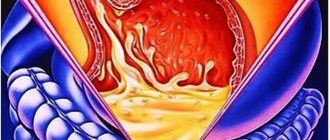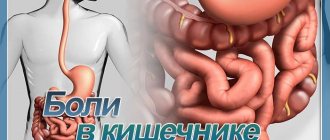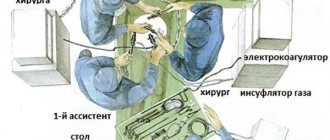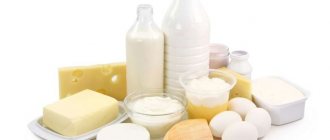04/30/201504/22/2015 IrinaGastrointestinal diseases
Putrefactive dyspepsia is a digestive disorder characterized by the incomplete breakdown of the protein part of food with the formation of a large amount of toxic substances and corresponding symptoms in the form of stool disorders, abdominal pain and dysbiosis.
- 2 How the process develops
- 3 Symptoms of putrefactive dyspepsia
3.1 Signs in the photo
- 6.1 Folk remedies for putrefactive dyspepsia in the photo
Symptoms
Putrefactive dyspepsia is accompanied by many signs that manifest themselves both from the digestive organs and from general clinical symptoms. The patient's complaints are always unstable and varied. The pathology often mimics other diseases, which makes diagnosis and timely therapy difficult.
Symptoms are seasonal - the condition worsens more often in the autumn-spring period. Exacerbations often occur in the morning and smooth out as the day progresses. The disease is chronic; acute processes are extremely rare and quickly resolve without specific therapy.
Intestinal manifestations
Among the symptoms indicating a disorder of the digestive system are:
- belching;
- nausea;
- uncontrollable vomiting of food;
- spasmodic pain in the abdominal area (intestinal colic);
- rumbling along the intestines;
- tenesmus (false, painful urge to defecate that does not produce results);
- loose, foul-smelling, dark-colored stools;
- flatulence and severe bloating;
- feeling of heaviness in the abdomen.
Extraintestinal manifestations
Among the general clinical symptoms, primarily intoxication and psychosomatic symptoms are distinguished. The main manifestations are as follows:
- fever at subfebrile-febrile levels (not higher than 38 ˚C);
- loss of appetite;
- headaches accompanied by dizziness;
- drowsiness and increased fatigue during the day;
- lethargy;
- apathy, reluctance to do anything, which ends in depressive states;
- feeling of unmotivated fear, anxiety;
- paresthesia (sensitivity disturbances in the form of tingling, numbness, burning sensation) in the epigastric region;
- insomnia;
- menstrual irregularities;
- manifestations of impotence.
The longer the disease lasts, the more serious the symptoms. Psychosomatic symptoms worsen and may lead the patient to see a psychologist or psychiatrist. Psychocorrection in this case does not bring any results, which drives the person even more into depression.
Diagnosis of the disease
When examined by a doctor, palpation clearly shows bloating; rumbling and transfusion can be heard in different parts of the abdomen.
The main method for identifying the disorder is scatological analysis of stool, which determines the presence of undigested food residues (fiber fibers), starchy clots, iodophilic bacteria, and increased acidity.
Metabolic disorders are determined by a biochemical blood test.
With the help of FGDS, the mucous membrane of the upper gastrointestinal tract is examined in order to exclude its damage.
Contrast radiography is performed if a peptic ulcer is suspected.
Ultrasound of the abdominal organs helps to establish or refute oncology, cholelithiasis, pancreatitis.
The diagnosis is made in the absence of pathological changes in the internal organs. Symptoms of the disorder should be observed for at least three months, and the first signs should appear about six months ago.
Causes
Predisposing factors that can lead to the development of putrefactive dyspepsia include:
- sedentary lifestyle;
- stressful situations;
- chronic diseases of the digestive tract.
Eating disorder
Among the main reasons, nutritional disorders occupy an important place:
- Binge eating. An abundance of food leads to decompensation of the digestive glands, which do not have time to synthesize enzymes for such a volume of food.
- The predominance of protein foods over plant foods. An unbalanced diet leads to enzymatic deficiency against the background of intestinal atony, since plant foods, due to the abundance of fiber, can stimulate peristalsis. This enhances the processes of decay and fermentation, and provokes the development of dysbiosis.
- Eating expired foods. Most often, putrefactive dyspepsia accompanies food poisoning, when toxins enter the gastrointestinal tract with food and provoke the development of rotting and fermentation processes, inactivation of enzymes.
Enzyme deficiency
Enzyme deficiency is most often observed with organic or functional disorders of the gastrointestinal tract itself:
- Pancreatitis. Inflammation of the pancreas of any etiology (alcoholic, infectious, cryptogenic) leads to a decrease in the function of glandular cells and a decrease in the secretion of pancreatic enzymes. Pancreatic enzymes (pepsin, trypsin, protease) promote protein digestion.
- Aminoacidopathy. Genetic pathology accompanied by a total disruption of amino acid synthesis. This leads to disruption of the synthesis of enzymes involved in protein digestion.
- Crohn's disease. A chronic autoimmune disease that is characterized by ulceration of mucosal areas throughout the gastrointestinal tube. Glandular cells are also affected. This leads to a deficiency of enzymes capable of digesting proteins.
- Phenylketonuria. Deficiency of the liver enzyme phenylalanine leads to impaired breakdown of amino acids.
- Celiac disease. A congenital pathology in which there are not enough villi in the small intestine capable of transport and exchange between the lumen of the gastrointestinal tube and the human body. This leads to increased decay processes of unabsorbed protein substances.
Read on topic: Methods for improving digestion and metabolism
What does fermentative dyspepsia mean? What symptoms are observed, how to treat, nutrition
The main causes of dyspepsia are a lack of digestive enzymes, causing malabsorption syndrome, or, what happens most often, gross errors in nutrition. However, no organic pathology is detected during the examination. In almost half of the cases, FD occurs in combination with irritable bowel syndrome, so experts classify it as a group of biopsychosocial diseases. The main causes of Functional dyspepsia include psychological trauma and stress. In some cases, the cause of the disease is an increase in the susceptibility of the gastric wall to stretching; in such patients, as a rule, the motor function of the stomach is not impaired. If the pathology is accompanied by symptoms characteristic of a peptic ulcer, then the cause of dyspepsia in this case may be the release of hydrochloric acid in a volume exceeding the norm. In the development of intestinal dyspepsia, constitutional weakness of the intestine, as well as sensitization and increased sensitivity to certain types of food - protein, carbohydrate or fat, are of known importance. Along with changes in intestinal flora, a certain role in the development of fermentative dyspepsia is played by the reduced secretion of diastase by the pancreas, as a result of which the process of carbohydrate breakdown is disrupted.
Diagnosis of the causes of putrefactive dyspepsia
To prescribe the correct treatment, it is necessary to identify the underlying cause and direct therapy towards the correction of disorders. Most often, putrefactive dyspepsia is a functional disorder that does not require serious treatment. But it is necessary to exclude serious organic damage that requires emergency measures: gastritis, gastric and duodenal ulcers, oncopathology, and so on.
The following diagnostic methods are used:
- Coprogram. It will allow you to identify digestion disorders in the form of the appearance of undigested fibers.
- Ultrasound of the digestive organs. Allows you to identify pathologies of the pancreas, liver and gallbladder, as well as dyskinesia of the bile ducts, which can lead to symptoms similar to dyspepsia.
- FGDS. Endoscopic examination makes it possible to exclude reflux disease, gastritis, ulceration of the stomach and the initial part of the small intestine, and oncopathology due to visualization of the mucous membrane and the ability to take material for a biopsy.
- X-ray with contrast. Visualization of the progress of the contrast agent through the gastrointestinal tract allows us to identify disturbances in the motility of the intestinal tube.
If further differential diagnosis is necessary, other research methods are also prescribed.
Diet for functional dyspepsia
Abstract: Lectures - Therapy of intestinal diseases The small and large intestines are the longest sections of the digestive tract. Digestion processes are associated with the intestines. Diagnosis of intestinal diseases, especially large intestines, is quite difficult. In an outpatient clinic setting, this may simply be impossible.
There are hereditary and acquired malabsorption syndromes.
Treatment
Treatment of the disease is based on diet therapy; medications are only an auxiliary aid in the acute period.
Diet
Dietary measures must be followed in a comprehensive manner: not only are contraindicated foods excluded from the patient’s daily diet, but the food intake regimen itself is reviewed.
Basic principles
After establishing the final diagnosis, the doctor’s main appointment is to transfer the patient to absolute fasting. Hunger lasts until the intestines are completely cleansed - on average for 1-3 days. During hunger, you can drink water and unsweetened strong tea, preferably green, in unlimited quantities, but in small, frequent portions.
Over the next two to three weeks, a long list of protein foods is excluded from the diet, and they begin to overcome hunger by taking simple carbohydrates, which are necessary for quickly restoring energy costs.
Meals are taken every 3-4 hours, on average at least 4 times a day. Portions are fractional and small. The patient gets up from the table with a slight feeling of hunger. Dishes are warm, preference is given to thermally processed food.
Products
As for food products, the patient is provided with a list of permitted and contraindicated products from which he makes up his diet:
| Recommended Products | Not Recommended Products |
|
|
Drugs
The main groups of drugs that are used in the acute period of the disease are as follows:
- Antacids. They allow you to neutralize hydrochloric acid and stop the rotting process. Preparations: Maalox, Phosphalugel.
- Enzymes. Allows you to improve digestion and short-term compensate for pancreatic insufficiency. Drugs: Festal, Creon, Pancreatin and others.
- Antispasmodics. They help reduce the intensity of intestinal colic and are used as symptomatic therapy. Drugs: Drotaverine, No-Shpa, Papaverine and others.
- Adsorbents. Allows you to reduce gas formation and remove toxins from the intestines. Preparations: Atoxil, White carbon, Activated carbon.
- Prokinetics. They improve and normalize peristalsis and have an antiemetic effect. Drugs Domperidone, Metoclopramide.
Disease prevention
In the first three months after the birth of a child, which are considered the most difficult for the whole family, young mothers are recommended to perform certain actions:
- Eat a balanced diet low in carbohydrates;
- it is very important to avoid overfeeding the baby;
- completely eliminate carbonated drinks and foods that cause fermentation in the body from your personal diet;
- give up bad habits - smoking and drinking alcoholic beverages, regardless of the amount of ethanol in them;
- perform exercises for infants and water procedures with the baby;
- visit your doctor regularly.
Following these simple rules will help to avoid problems with the child’s health and the development of fermentative dyspepsia.
Possible consequences and prognosis
In severe forms of dyspepsia, a person often develops signs of cachexia and rapid loss of body weight. A complication may develop in the form of Mallory-Weiss syndrome, which is characterized by recurrent cyclic vomiting and bleeding as a result of microtrauma of the mucous membrane. The condition is not life threatening.
More serious are mental disorders that lead to severe depressive states and force the patient to turn to psychotherapists. Treatment does not bring relief.
The prognosis with proper therapy and subsequent prevention is favorable. The function of the gastrointestinal tract is completely restored.
Development mechanism
If the food products that a person consumes have an increased concentration of proteins, then the stomach cannot fully digest them. In a semi-digested form, they enter the large intestine, where they begin to gradually decompose under the influence of the bacteria that live there. As a result, bacterial agents displace beneficial microflora, and dysbacteriosis progresses.
If protein compounds begin to rot in the intestines, this poisons the entire human body as a whole. Toxins are formed that penetrate the bloodstream. Because of this, the body activates all its protective mechanisms - the process of fluid absorption decreases, nausea and vomiting occur, and intestinal motility becomes more intense.
Definition of the term
Normally, the biochemical reaction of the breakdown of protein molecules into amino acids occurs in the small intestine. The disease complicates the process of digesting proteins and their absorption by the body. Next, undigested proteins enter the large intestine, where they undergo a putrefactive process, with a gross disruption of the digestive process and the formation of toxic decomposition products.
The reaction of protein breakdown is impossible without the participation of:
With putrefactive dyspepsia, microorganisms begin to produce large amounts of endotoxin, which causes an inflammatory reaction, capturing the inner wall of the large intestine, liver, and blood vessels. The body's immune system responds to the presence of a toxic toxin with an allergic reaction.
Indigestion of protein foods is accompanied by the release of ammonia, which disrupts the functioning of the nervous system and causes oxygen starvation of the brain and other organs.
The pathological process continues. The contents of the intestine turn into a gel, the intestinal walls swell, become inflamed, and function is impaired.
Classification of putrefactive dyspepsia.
- Spicy.
- Chronic – sluggish form, with periodic exacerbations.
The acute form of dyspepsia is usually distinguished by the following characteristics.
By origin. Due to:
- dysfunction of the gastrointestinal tract;
- complications after infectious diseases;
- inherited pathologies;
- constitutional, anatomical features of the structure of internal organs.
According to the location of the inflammatory process.
- stomach with small intestine;
- small intestine;
- total damage to all parts of the intestine;
- the entire digestive tract from the stomach to the lower parts of the large intestine.
According to the degree of organ damage:
- 1st degree – no intoxication or dehydration;
- Grade 2 – there are mild signs of symptoms of dehydration and internal intoxication;
- Grade 3 – symptoms of dehydration and internal intoxication are clearly expressed.
The chronic form affects people of any age.
Relapses occur when the diet is violated by heavy food lovers or from inadequate treatment.
In the classification of the chronic form of dyspepsia, it is customary to distinguish degrees:
- Mild – symptoms of dehydration are noticeable, there is no intoxication.
- Medium – metabolic reactions in the body are disturbed. Noticeable weight loss.
- Severe – the daily amount of urine excreted decreases, blood pH shifts to the acidic side, and neurotic disorders are observed.
Summary for parents
Fermentative dyspepsia is most often a mild digestive disorder, which, with timely and proper treatment, will not leave negative consequences. The disease can be completely avoided by providing proper nutrition to the child.
If you identify signs of fermentative dyspepsia, you need to consult a doctor to find out the cause of the developed digestive disorder and get the right medical help. This will prevent dyspepsia from becoming chronic.
Functional dyspepsia occurs regularly in young children. This problem causes discomfort in the upper abdomen and causes the baby a lot of pain. Since the disease significantly worsens the child’s quality of life, parents try to cope with it as soon as possible.











